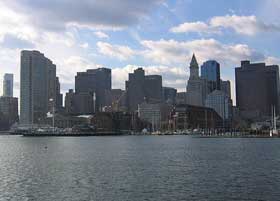Post Date: May 5, 2005
In the past two decades, Boston Harbor has gone from being the nation’s most degraded to a symbol of national pride. Where 12 billion gallons of raw or partially treated sewage once flowed in each year, dolphins and seals are now returning, waterfront businesses are thriving, and a state-of-the art sewage treatment plant is whirring away on Deer Island. That turnabout is thanks to, in part, one judge and his special master: Charles Haar, professor at Harvard Law School.
Haar’s new book, “Mastering Boston Harbor: Courts, Dolphins, and Imperiled Waters,” chronicles the harbor’s stunning transformation, and offers a behind-the-scenes look at the innovative approaches used by the judiciary to force other branches of government to take action.
Similar approaches, Haar says, may be helpful in other institutional breakdown cases, such as failing schools or jails. “When you have a freezing of the political pipes, the judge, with great care and caution, has to apply heat,” he says.
Such was the case with Boston Harbor. In 1982, the city of Quincy, Mass. filed suit against the Metropolitan District Commission and the Boston Water and Sewer Commission, the local agencies responsible for the sewerage system that served more than two million residents in the Boston metropolitan area. According to Haar, Quincy’s beaches and waters were polluted not only with a nauseating array of human feces and garbage—but also with politics.
Decades of prior attempts by governors and state legislators to clean up the harbor had led nowhere. Such failure was due to gridlock, patronage, and “everybody acting as bureaucrats do naturally—for their own turf,” says Haar. “They left it to the judiciary to rise to the challenge.”
When the trial began in July 1983, Paul Garrity was the presiding judge, and Haar, a Harvard Law professor at the time, was appointed by the Massachusetts Superior Court as a special master in the case. Special masters are allowed only in extremely complex cases; Haar’s job was to research the daunting sewage problems and to recommend remedies. So with the help of local experts—three professors from Harvard and MIT, and four Harvard Law students—Haar put together a report that described the many faults in the MDC sewage treatment system and recommended legislation creating a new water and sewage treatment authority.
“There was no one agency that had the real governmental authority or the finances or the staffing or the strategy to clean up the harbor,” explains Haar. “The functions were so broken up and so divided among different entities [that] you needed this new agency.”
Next, Haar educated various groups and elected officials about his findings, and monitored the progress made on restoring and governing the harbor. Garrity spent endless months pleading and prodding the legislature to come to a compromise bill on the new agency. More than a year later, there was not much progress to report.
“The legislature feared that if they passed anything on the new agency, the sewer rates would go up and they’d lose the next election,” recalls Haar, adding that Boston’s sewer rates were actually some of the lowest in the country. Moreover, Governor Michael Dukakis “had too many agencies, federal as well as state, to contend with … and politicians in the ’80s did not foresee that the environment was a great political issue that the public would care so much about,” he adds.
Fed up with legislative gridlock and inaction, Garrrity finally resorted to more drastic measures. In November and December of 1984, he threatened to place the sewer division of the MDC into judicial receivership, and he issued an order declaring a moratorium on new sewer system hookups, which would bring construction in the metropolitan area to a virtual standstill. Fearing lost revenue in the hundreds of millions, the business community put further pressure on the legislature.
Eventually, Garrity’s tactics worked: On Dec. 19, 1984, the House and Senate passed the bill by large majorities, and the Massachusetts Water Resources Authority was created.
The harbor’s massive cleanup would entail many more trials and triumphs in the years that followed, but it was the Quincy case that spurred its progress.
At a time when judicial activism is receiving increased scrutiny, Harr maintains that the court’s actions were necessary and appropriate. “Without judicial intervention, the legal wrongs—the violation of the Massachusetts Clean Waters Act, among others—would have continued … and the sewage problems would have remained for decades.”
In his book, Haar offers many recommendations for the future, including the need to lift the ban on court-appointed engineers, scientists, and other experts—who can be vitally useful in explaining complex issues to judges and lawyers—and to modify the federal rules limiting the appointment of a special master to “extraordinary” cases.
Reflecting on his experience, Haar notes, “It was wonderful to have the opportunity to be in a case like this that was able to do so much good in the community.” And he writes in his book, “As usual, Justice Holmes was right on point when he urged the lawyer to ‘wreak himself upon life’ and engage in the actions and passions of his own time.”
—Sara Steindorf
